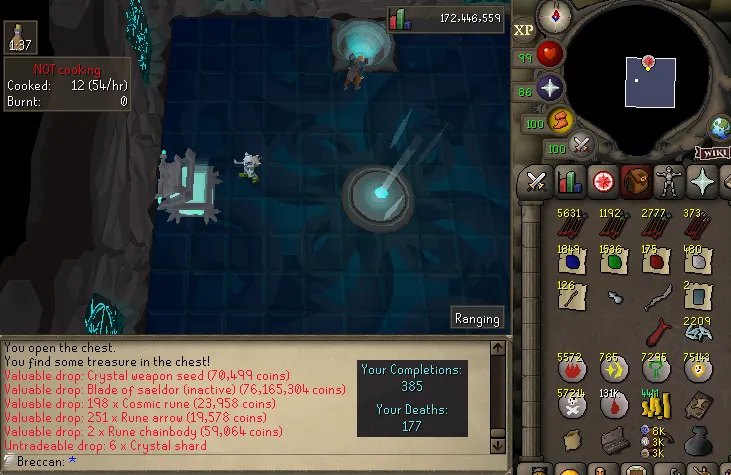Your cart is empty
How to Charge Blade of Saeldor in OSRS A Step-by-Step Guide

The Blade of Saeldor is one of the most coveted weapons in Old School RuneScape (OSRS), known for its exceptional slash and strength bonuses. However, to keep this elven blade at peak performance, you need to charge it with crystal shards, a process that can seem daunting for new players. In this comprehensive guide, we’ll walk you through everything you need to know about charging the Blade of Saeldor, from gathering shards to corrupting the blade for permanent use. Whether you’re a seasoned adventurer or just starting your journey in Prifddinas, this guide will help you maintain your blade efficiently.
The Blade of Saeldor is a one-handed melee weapon requiring 80 Attack to wield. It’s crafted from an enhanced crystal weapon seed and 100 crystal shards, offering a +94 slash bonus and +89 strength bonus, making it a top-tier choice for PvM and PvP. However, the blade degrades with use, losing one charge per attack until it becomes inactive, at which point it loses its combat bonuses. Charging it with crystal shards restores its power, and understanding this mechanic is key to maximizing its potential.
Why Charging Matters
An uncharged or inactive Blade of Saeldor is essentially useless in combat, as it reverts to a tradeable, non-functional state. Regularly charging it ensures you maintain its best-in-slot (BiS) status for slash-based combat, ideal for bosses like those in the God Wars Dungeon or high-level slayer tasks.
Charged vs. Corrupted Blade
There are two ways to manage the blade’s charges: regular charging, where you add shards periodically, or corrupting it, which makes it permanently charged but untradeable. Each option has its pros and cons, which we’ll explore later in this guide.
Gathering Crystal Shards
Crystal shards are the lifeblood of the Blade of Saeldor, used both to create and charge it. These untradeable resources are exclusive to Prifddinas, accessible after completing the Song of the Elves quest. Here’s how to gather them efficiently.
Methods to Obtain Crystal Shards
- The Gauntlet: Completing the regular Gauntlet yields 3–7 shards per run, while the Corrupted Gauntlet offers 5–9 shards. This is the fastest method for high-skill players, averaging 50–70 shards per hour in the Corrupted version.
- Zalcano: This skilling boss drops 8–20 shards per kill in a busy world, making it a solid option for group play. Expect 30–50 shards per hour depending on your team’s efficiency.
- Crystal Trees: Harvesting crystal trees provides a passive, AFK method, yielding 10–15 shards daily per tree. Check two trees for up to 30 shards per day with minimal effort.
- Other Activities: Thieving from Prifddinas elves (80 Thieving required) or completing rooftop agility courses can yield 1–3 shards per action, though these are slower methods.
Tips for Efficient Shard Farming
To optimize your shard collection, focus on your strengths. If you’re combat-savvy, prioritize the Corrupted Gauntlet for high shard output. For a more relaxed approach, combine Zalcano runs with daily crystal tree checks. Always keep an eye on your inventory space, as shards stack, but other loot from these activities might not.
Charging the Blade of Saeldor
Once you’ve gathered enough crystal shards, charging the Blade of Saeldor is straightforward but requires access to a singing bowl in Prifddinas. Here’s the step-by-step process.
Step-by-Step Charging Process
- Locate a Singing Bowl: Head to Prifddinas, specifically the Trahaearn district, where you’ll find a singing bowl in the crystal crafting area.
- Check Blade Status: Right-click the Blade of Saeldor in your bank or inventory and select “Configure-Charges” to see its current charge level. A new blade starts with 10,000 charges, while a fully charged one holds up to 20,000.
- Add Shards: Use crystal shards on the singing bowl with the blade in your inventory. Each shard adds 100 charges, so 100 shards restore 10,000 charges.
- Confirm Charges: After adding shards, check the blade’s charge status again to ensure it’s ready for combat.
Charging Costs and Considerations
Charging the blade is relatively affordable in terms of shards, but the time investment in gathering them can add up. For example, fully charging a blade from inactive to 20,000 charges requires 200 shards, which could take 3–4 hours in the Corrupted Gauntlet. In PvP, be cautious—an unprotected death drops the inactive blade, losing all charges, while PvM deaths preserve them.
| Charge Level | Shards Required | Approximate Time (Corrupted Gauntlet) |
|---|---|---|
| 10,000 (Default) | 100 | 1.5–2 hours |
| 20,000 (Max) | 200 | 3–4 hours |
Corrupting the Blade of Saeldor
For players seeking a low-maintenance option, corrupting the Blade of Saeldor creates a Blade of Saeldor (c), which never degrades. This comes at a steep cost but eliminates the need for constant recharging.
How to Corrupt the Blade
To corrupt the blade, you’ll need 1,000 crystal shards and access to a singing bowl. If you lack 82 Smithing and Crafting, Conwenna or Reese can corrupt it for an additional 500 shards, totaling 1,500. The process grants no experience, and excess charges on the blade reduce the shard cost (e.g., a blade with 10,000 charges needs only 900 shards).
Pros and Cons of Corruption
- Pros:
- Permanent charges, no upkeep required.
- Customizable colors via Lliann’s Wares for 500,000 coins per crystal, adding aesthetic flair.
- Ideal for long-term use in high-intensity PvM.
- Cons:
- High initial cost (1,000–1,500 shards, or 15–22 hours of Gauntlet grinding).
- Untradeable, locking in your investment unless reverted (losing all shards).
- No significant combat advantage over a charged blade.
Is Corruption Worth It?
Corrupting the blade depends on your playstyle. If you use the Blade of Saeldor frequently for bossing or slayer and have shards to spare, corruption saves time and hassle. However, if you’re still building your bank or prefer flexibility, stick to regular charging and consider selling the blade if needed.
Tips for Managing Blade Charges Long-Term
Maintaining the Blade of Saeldor doesn’t have to be a chore. With the right strategies, you can keep it charged and ready for action without burning out on shard grinding.
Optimize Shard Collection
Combine active and passive methods for a balanced approach. Run the Corrupted Gauntlet during focused play sessions, check crystal trees daily, and join Zalcano groups when you’re in a social mood. This variety keeps shard farming engaging.
Use the Blade Strategically
Reserve the Blade of Saeldor for high-value activities where its slash bonus shines, like fighting slash-weak bosses (e.g., Kree’arra) or specific slayer tasks (e.g., jellies). For general training, cheaper alternatives like the Abyssal Whip can save charges.
Monitor Market Trends
The Blade of Saeldor’s inactive form is tradeable, and its price fluctuates based on supply and demand. Check the Grand Exchange regularly to decide whether to sell or hold onto your blade, especially if you’re not ready to corrupt it.
Plan for Corruption
If you’re leaning toward corrupting the blade, start stockpiling shards early. Set a goal of 100 shards per week to make the 1,000-shard cost feel less overwhelming. Joining a clan for Zalcano runs can speed up this process significantly.
Charging the Blade of Saeldor in OSRS is a manageable task once you understand the mechanics and shard-gathering methods. Whether you choose to charge it periodically or invest in corruption, this powerful weapon can elevate your combat experience across Gielinor. By farming shards efficiently and using the blade strategically, you’ll ensure it remains a cornerstone of your arsenal. Ready to take on the Gauntlet or Zalcano? Grab your gear, head to Prifddinas, and keep that blade shining!
